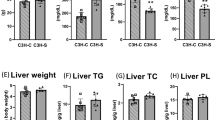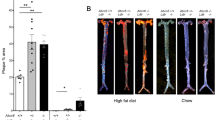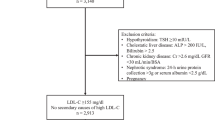Abstract
Mutations in the low density lipoprotein (LDL) receptor gene cause familial hypercholesterolemia, a human disease characterized by premature atherosclerosis and markedly elevated plasma levels of LDL cholesterol and apolipoprotein (apo) B100. In contrast, mice deficient for the LDL receptor (Ldlr−/−) have only mildly elevated LDL cholesterol levels and little atherosclerosis. This difference results from extensive editing of the hepatic apoB mRNA in the mouse, which limits apoB100 synthesis in favor of apoB48 synthesis. We have generated Ldlr−/− mice that cannot edit the apoB mRNA and therefore synthesize exclusively apoBIOO. These mice had markedly elevated LDL cholesterol and apoBIOO levels and developed extensive atherosclerosis on a chow diet. This authentic model of human familial hypercholesterolemia will provide a new tool for studying atherosclerosis.
This is a preview of subscription content, access via your institution
Access options
Subscribe to this journal
Receive 12 print issues and online access
$209.00 per year
only $17.42 per issue
Buy this article
- Purchase on Springer Link
- Instant access to full article PDF
Prices may be subject to local taxes which are calculated during checkout
Similar content being viewed by others
References
Goldstein, J.L., Hobbs, H.H. & Brown, M.S. Familial hypercholesterolemia. in The Metabolic and Molecular Bases of Inherited Disease, Vol. 2 (eds. Scriver, C.R., Beaudet, A.L., Sly, W.S. & Valle, D.) 1981–2030 (McGraw-Hill, New York, 1995).
Breslow, J.L. Transgenic mouse models of lipoprotein metabolism and atherosclerosis. Proc. Natl.Acad. Sci. USA 90, 8314–8318 (1993).
Kim, E. & Young, S.G. Genetically modified mice for the study of apolipoprotein B. J. Lipid Res. 39, 703–723 (1998).
Ishibashi, S. et al. Hypercholesterolemia in low density lipoprotein receptor knockout mice and its reversal by adenovirus-mediated gene delivery. J. Clin. Invest. 92, 883–893 (1993).
Ishibashi, S., Goldstein, J.L., Brown, M.S., Herz, J. & Burns, D.K. Massive xan-thomatosis and atherosclerosis in cholesterol-fed low density lipoprotein receptor-negative mice. J. Clin. Invest. 93, 1885–1893 (1994).
Davidson, N.O., Anant, S. & MacGinnitie, A.J. Apolipoprotein B messenger RNA editing: Insights into the molecular regulation of post-transcriptional cytidine deamination. Curr. Opin. Lipidol. 6, 70–74 (1995).
Ishibashi, S. Herz, J., Maeda, N., Goldstein, J.L. & Brown, M.S. The two-receptor model of lipoprotein clearance: Tests of the hypothesis in “knockout” mice lacking the low density lipoprotein receptor, apolipoprotein E, or both proteins. Proc. Natl. Acad. Sic. USA 91, 4431–4435 (1994).
Herz, J. & Willnow, T.E. Lipoprotein and receptor interactions in vivo . Curr. Opin. Tipi dol. 6, 97–103 (1995).
Rohlmann, A., Cotthardt, M., Hammer, R.E. & Herz, J. Inducible inactivation of hepatic LRP gene by Cre-mediated recombination confirms role of LRP in clearance of chylomicron remnants. J. Clin. Invest. 101, 689–695 (1998).
Davidson, N.O., Carlos, R.C., Drewek, M.J. & Parmer, T.G. Apolipoprotein gene expression in the rat is regulated in a tissue-specific manner by thyroid hormone. J. Lipid Res. 29, 1511–1522 (1988).
Davidson, N.O. et al. Proposed nomenclature for the catalytic subunit of the mammalian apolipoprotein B mRNA editing enzyme: APOBEC-1. RNA 1, 3 (1995).
Piedrahita, J.A., Zhang, S.H., Hagaman, J.R., Oliver, P.M. & Maeda, N. Generation of mice carrying a mutant apolipoprotein E gene inactivated by gene targeting in embryonic stem cells. Proc. Natl. Acad. Sci. USA 89, 4471–4475 (1992).
Zhang, S.H., Reddick, R.L., Piedrahita, J.A. & Maeda, N. Spontaneous hypercho-lesterolemia and arterial lesions in mice lacking apolipoprotein E. Science 258, 468–471 (1992).
Reddick, R.L., Zhang, S.H. & Maeda, N. Atherosclerosis in mice lacking apo E. Evaluation of lesional development and progression. Arterioscler. Thromb. 14, 141–147 (1994).
Plump, A.S. et al. Severe hypercholesterolemia and atherosclerosis in apolipoprotein E-deficient mice created by homologous recombination in ES cells. Cell 71, 343–353 (1992).
Nakashima, Y., Plump, A.S., Raines, E.W., Breslow, J.L. & Ross, R. ApoE-deficient mice develop lesions of all phases of atherosclerosis throughout the arterial tree. Arterioscler. Thromb. 14, 133–140 (1994).
Farese, R.V. Jr et al. Phenotypic analysis of mice expressing exclusively apolipoprotein B48 or apolipoprotein B100. Proc. Natl. Acad. Sci. USA 93, 6393–6398 (1996).
Purcell-Huynh, D.A. et al. Transgenic mice expressing high levels of human apolipoprotein B develop severe atherosclerotic lesions in response to a high-fat diet. J. Clin. Inyest. 95, 2246–2257 (1995).
Liao, F., Andalibi, A., deBeer, F.C., Fogelman, A.M. & Lusis, A.J. Genetic control of inflammatory gene induction and NF-KB-like transcription factor activation in response to an atherogenic diet in mice. J. Clin. Invest. 91, 2572–2579 (1993).
Fazio, S. et al. Increased atherosclerosis in mice reconstituted with apolipoprotein E null macrophages. Proc. Natl. Acad. Sci. USA 94, 4647–4652 (1997).
Linton, M.F., Babaev, V.R., Gleaves, L.A., Atkinson, J.B. & Fazio, S. Increased atherosclerosis in C57BL/6 mice transplanted with apolipoprotein E-deficient marrow. Circulation 94 IM (1996).
Bellosta, S. et al. Macrophage-specific expression of human apolipoprotein E reduces atherosclerosis in hypercholesterolemic apolipoprotein E-null mice. J. Clin. Invest. 96, 2170–2179 (1995).
Willnow, T.E., Sheng, Z., Ishibashi, S., St Herz, J. Inhibition of hepatic chylomicron remnant uptake by gene transfer of a receptor antagonist. Science 264, 1471–1474 (1994).
Brown, M.S., Herz, J., Kowal, R.C. & Goldstein, J.L. The low-density lipoprotein receptor-related protein: Double agent or decoy? Curr. Opin. Lipidol. 2, 65–72 (1991).
Willnow, T.E., Goldstein, J.L., Orth, K., Brown, M.S. & Herz, J. Low density lipoprotein receptor-related protein and gp330 bind similar ligands, including plasminogen activator-inhibitor complexes and lactoferrin, an inhibitor of chylomicron remnant clearance. J. Biol. Chem. 267, 26172–26180 (1992).
Véniant, M.M. et al. Susceptibility to atherosclerosis in mice expressing exclusively apolipoprotein B48 or apolipoprotein B100. J. Clin. Invest. 100, 180–188 (1997).
Sanan, D.A. et al. Low density lipoprotein receptor-negative mice expressing apolipoprotein B-100 develop complex atherosclerotic lesions on a chow diet: No accentuation by apolipoprotein(a). Proc. Natl. Acad. Sci. USA 95, 4544–4549 (1998).
Hirano, K.I. et al. Targeted disruption of the mouse apobec-1 gene abolishes apolipoprotein B mRNA editing and eliminates apolipoprotein B48. J. Biol. Chem. 271, 9887–9890 (1996).
Linton, M.F. et al. Transgenic mice expressing high plasma concentrations of human apolipoprotein B100 and lipoprotein(a). J. Clin. Invest. 92, 3029–3037 (1993).
Young, S.G., Bertics, S.J., Curtiss, L.K. & Witztum, J.L. Characterization of an abnormal species of apolipoprotein B, apolipoprotein B-37, associated with familial hypobetalipoproteinemia. J. Clin. Invest. 79, 1831–1841 (1987).
Kim, E., Cham, C.M., Véniant, M.M., Ambroziak, P. & Young, S.G. Dual mechanisms for the low plasma levels of truncated apolipoprotein B proteins in familial hypobetalipoproteinemia. Analysis of a new mouse model with a nonsense mutation in the Apob gene. J. Clin. Invest. 101, 1468–1477 (1998).
Palinski, W. et al. ApoE-deficient mice are a model of lipoprotein oxidation in atherogenesis. Demonstration of oxidation-specific epitopes in lesions and high titers of autoantibodies to malondialdehyde-lysine in serum. Arterioscler. Thromb. 14, 605–616 (1994).
Tangirala, R.K., Rubin, E.M. & Palinski, W. Quantitation of atherosclerosis in murine models: Correlation between lesions in the aortic origin and in the entire aorta, and differences in the extent of lesions between sexes in LDL receptor-deficient and apolipoprotein E-deficient mice. J. Lipid Res. 36, 2320–2328 (1995).
Author information
Authors and Affiliations
Corresponding author
Rights and permissions
About this article
Cite this article
Powell-Braxton, L., Véniant, M., Latvala, R. et al. A mouse model of human familial hypercholesterolemia: Markedly elevated low density lipoprotein cholesterol levels and severe atherosclerosis on a low-fat chow diet. Nat Med 4, 934–938 (1998). https://doi.org/10.1038/nm0898-934
Received:
Accepted:
Issue Date:
DOI: https://doi.org/10.1038/nm0898-934
This article is cited by
-
Fenretinide inhibits obesity and fatty liver disease but induces Smpd3 to increase serum ceramides and worsen atherosclerosis in LDLR−/− mice
Scientific Reports (2023)
-
Mechanistic understanding of in vivo protein corona formation on polymeric nanoparticles and impact on pharmacokinetics
Nature Communications (2017)
-
Survival or death: a dual role for autophagy in stress-induced pericyte loss in diabetic retinopathy
Diabetologia (2016)
-
Recent Developments in Gene Therapy for Homozygous Familial Hypercholesterolemia
Current Atherosclerosis Reports (2016)
-
Transcriptional and posttranscriptional mechanisms contribute to the dysregulation of elastogenesis in Schimke immuno-osseous dysplasia
Pediatric Research (2015)



